Yes, basketball’s fast-paced games, athletic shots, and last-second clutch plays are fun to discuss. But sometimes you’ve got to bring it back to the basics, like how many players form a basketball team?
It’s a simple yet fundamental question to understand the sport. Let’s dive into the essentials of basketball team sizes.
Key Takeaways:
- A basketball team has between 12 to 20 players. During a game, you’ll see 5 of these players playing on the court at a time.
- Different leagues may have different rules, with NBA teams typically having 15 players and NCAA teams having up to 13 scholarship players.
- Not all players on a team are active; some may be ‘benched’ or inactive during a game.
This guide is designed to answer your questions about how many players are in a basketball team. We’ll explore how team sizes vary from high school to professional leagues and why these differences matter.
Standard Roster Sizes in Basketball
So, how many players are on a basketball team?
Most basketball teams have between 12 to 15 players. But, some can have up to 20 players.
Why this range? It’s because different basketball leagues have their own rules about how many players a team can have. The goal is to give teams enough players to cover different positions and for substituting during games.
Even in the same league, teams might have different numbers of players. This can be due to budget reasons, like salary caps. A salary cap is a limit on how much money a team can spend on player salaries.
So, some teams might choose to have fewer players. This way, they can pay more to star players or balance their budget.
Learn more: What is a 3 and D player?
Comparing Team Sizes Across Leagues
Different basketball leagues have different rules for team sizes. Let’s look at how many players are typically on a team in various leagues, from professional to high school levels.
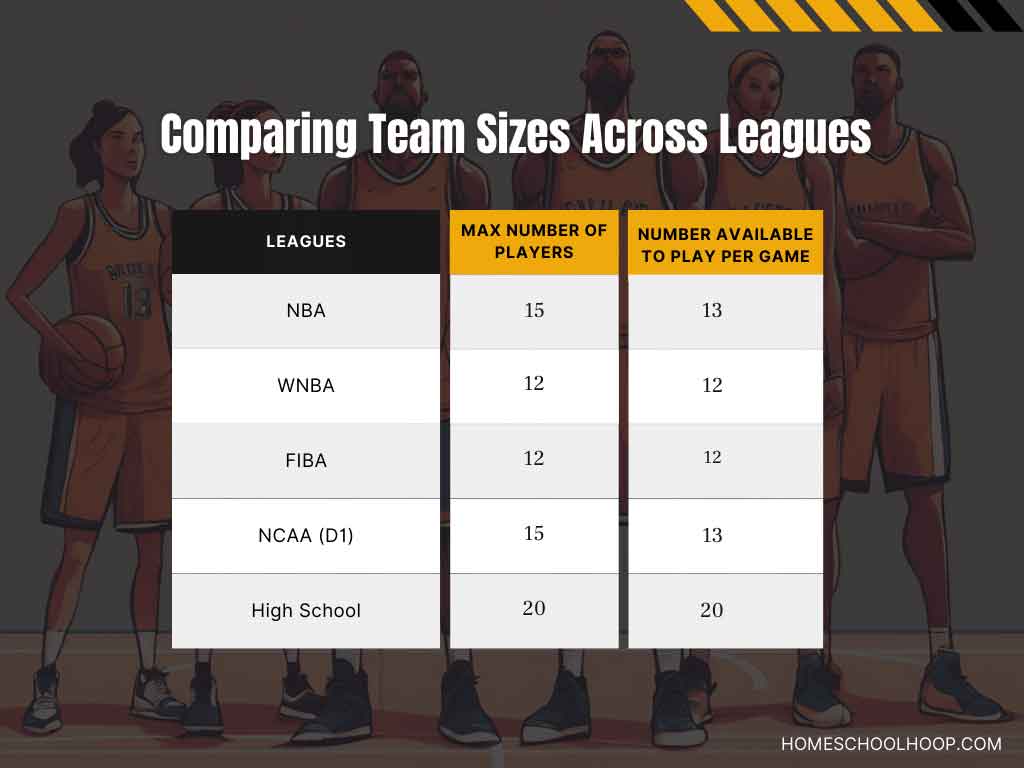
How Many Players Are on an NBA Team?
In the NBA, the men’s professional basketball league, teams are allowed 15 players on the team roster.
Once the regular season begins, NBA teams can have up to 15 players on their permanent roster. However, only 13 of these players can be dressed and active for a game. The remaining two NBA roster players are inactive but can be swapped in as needed throughout the season.
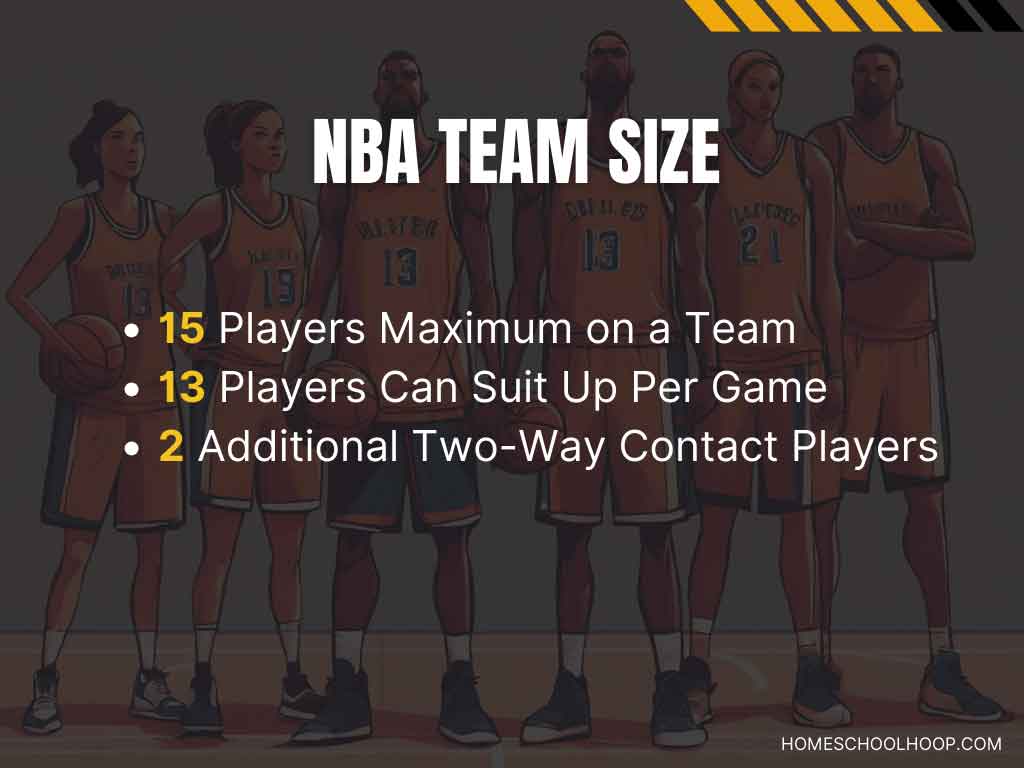
In the NBA, teams must have a minimum of 13 players on their active roster during the season. And on game days, they must have no fewer than 8 players suited up and available to play. The league can grant them a hardship exception when more than four players are injured to temporarily have 16 players on the roster.
NBA teams can have up to 20 players on their roster in the offseason. This allows general managers and coaches to bring in more players to compete for a spot on the squad before the regular season starts.
Two-Way Contract Players
In addition to the 15 players on the regular season roster, NBA teams can have two more players on two-way contracts. Two-way contracts are given to players who are still developing, and they’re able to split their play between the NBA franchise and the team’s G-League affiliate.
Learn more: Discover more about NBA players in our ultimate NBA fan guide.
How Many Players Are on a WNBA Team?
The WNBA, the women’s professional basketball league, allows a maximum of 12 players on each team roster.
This 12-player maximum does not include any players who are signed via the hardship exception. Teams can be granted hardship exceptions in the case that they lose two players due to injury, illness, or other issues.
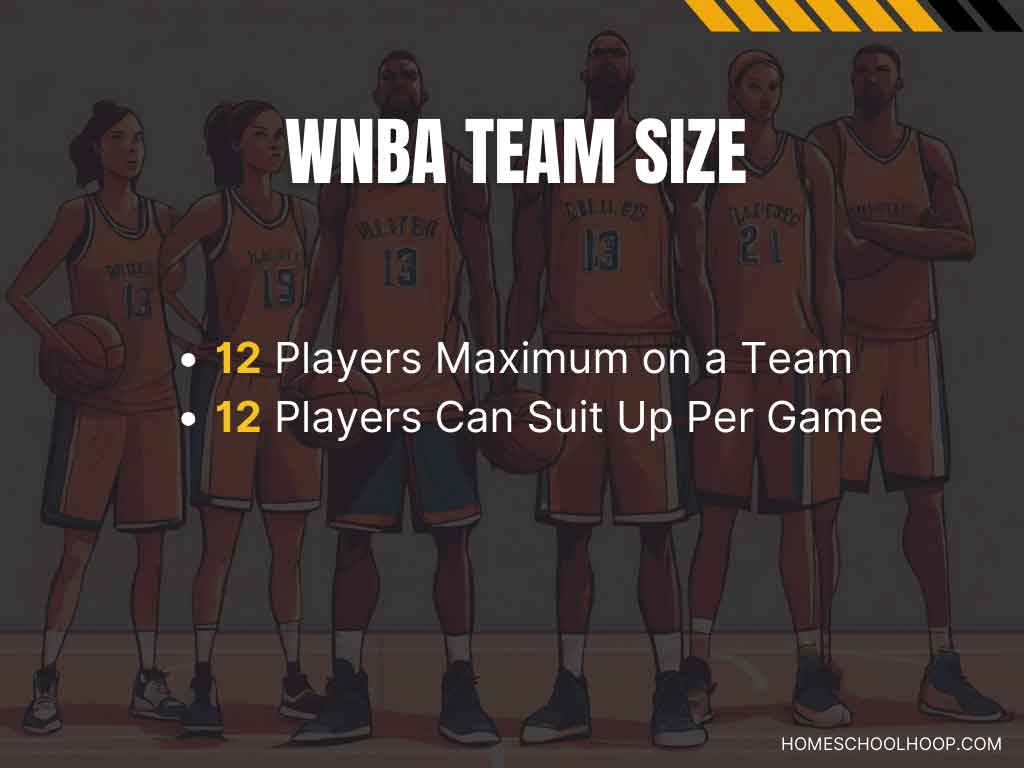
In the WNBA, teams must have at least 11 players on their active roster at all times during the season. They have 72 hours to sign another player in the event the team falls below 11.
The 12-player roster in the WNBA mirrors the structure of FIBA.
Learn more: Up your knowledge of the WNBA with our WNBA fan guide.
How Many Players Are on a FIBA Team?
Teams competing under FIBA rules can have rosters of up to 12 players.
FIBA, the International Basketball Federation, sets the guidelines for international basketball competitions.
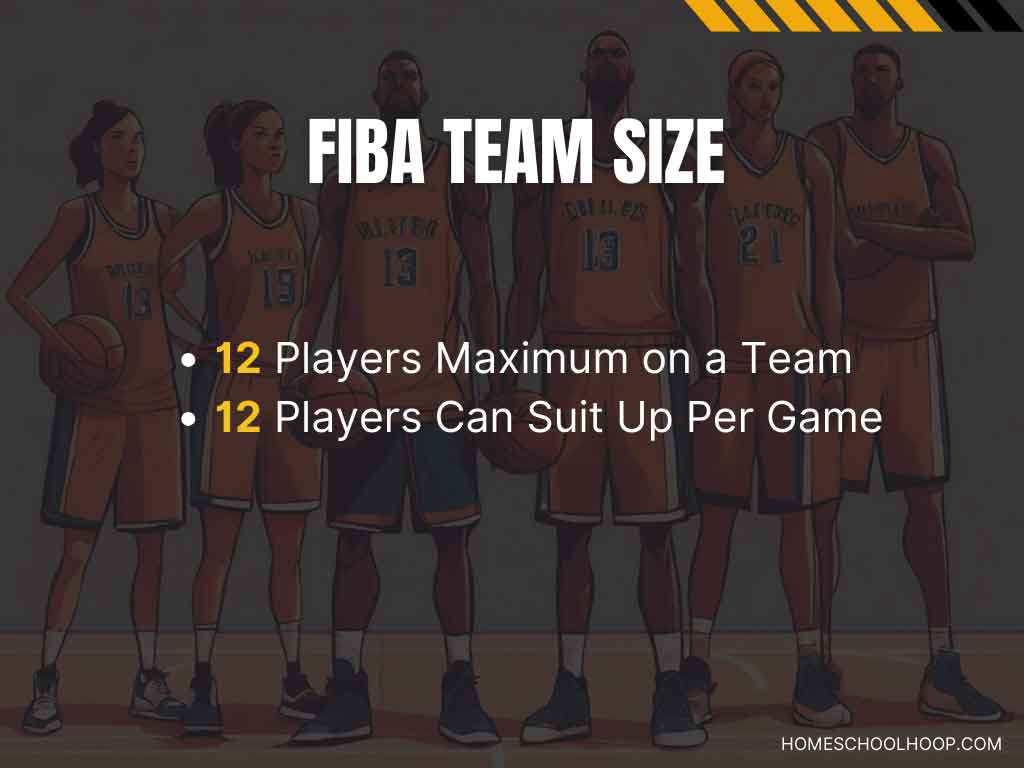
Under FIBA rules, of the 12 players on each country’s team, one can be naturalized. Naturalized players acquired their citizenship rather than always having it.
How Many Players Are on an NCAA Basketball Team?
In NCAA college basketball, teams can have up to 15 players on their roster during the season.
Not all NCAA teams carry a maximum of 15 players on their roster. In addition, NCAA Division I basketball teams can only offer up to 13 full-ride scholarships. Also, like in the NBA, only 13 active players can dress, sit on the bench, and be available to play at each game. The other two players cannot wear a uniform and must sit behind the bench.
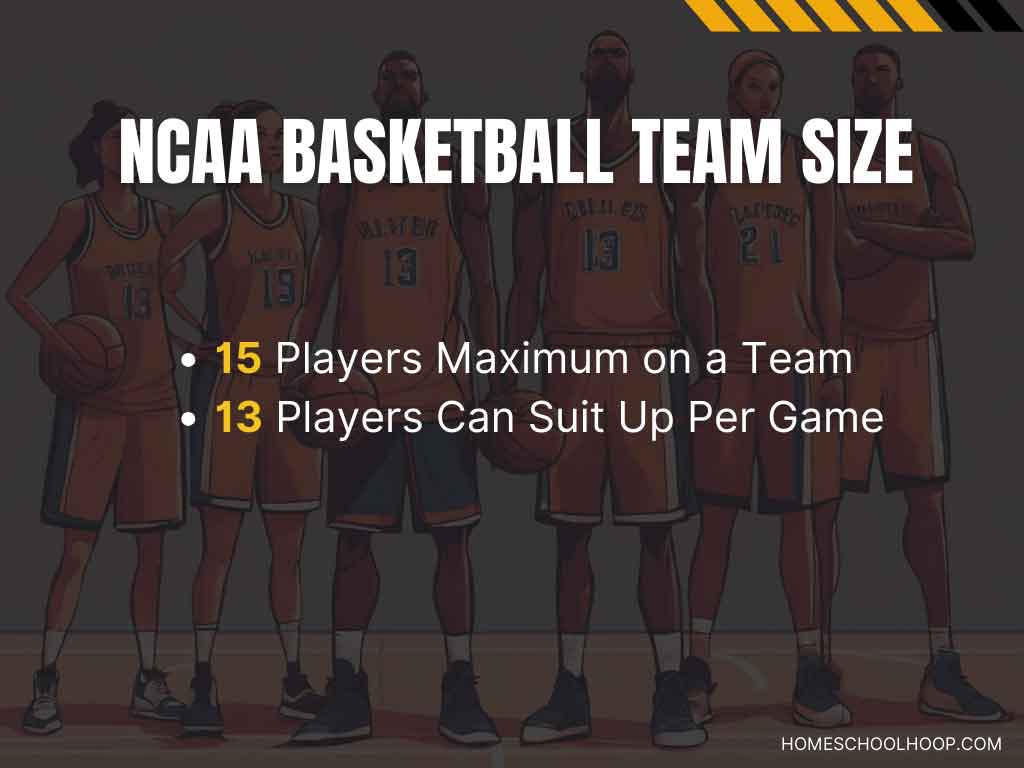
College basketball teams with larger programs often have the budget to travel with their full 15-player roster. However, it’s not unusual for smaller players to keep the two players not suiting up at home to save travel money.
How Many Players Are on a High School Basketball Team?
High school basketball teams can have a maximum of 20 players, under The National Federation of State High School Association (NFHS).
The NFHS writes the rules for most high school sports, but not all. And in reality, high school basketball teams often have more variability in team size. On average, these teams range from 12 to 15 players.
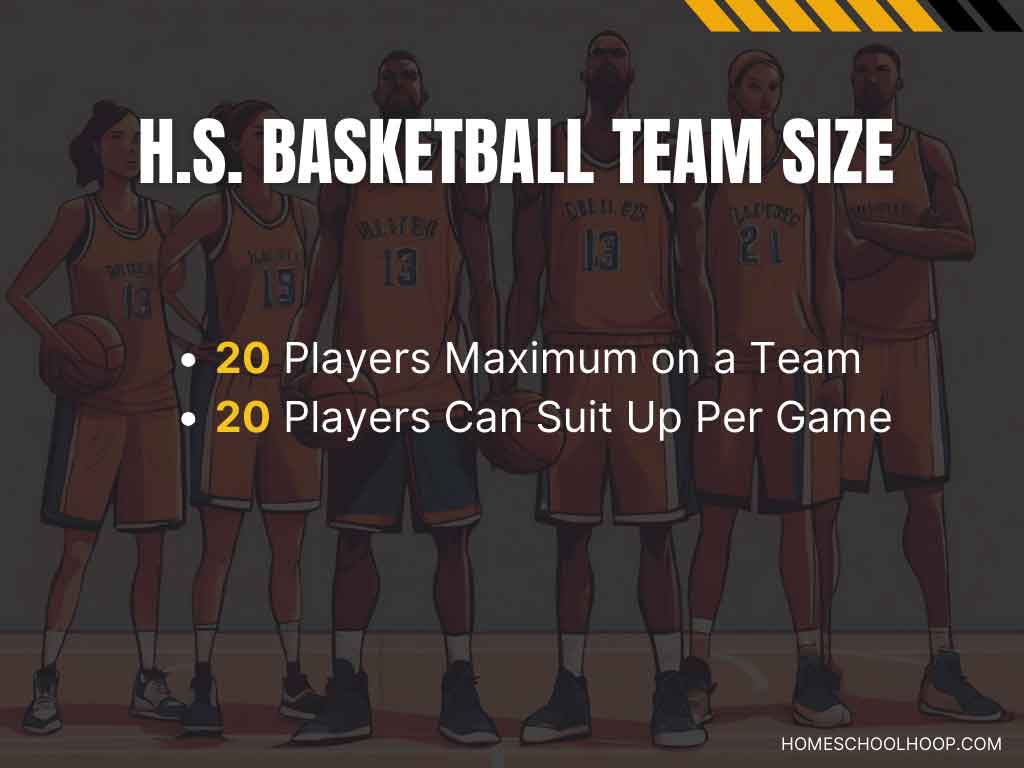
It makes sense that high school basketball teams are allowed more players than college and professional. This range allows more student athletes to participate and develop their skills in the sport.
Table 1. Maximum Number of Players on a Basketball Team By League
| LEAGUE | MAXIMUM NUMBER OF PLAYERS ON THE TEAM |
| NBA | 15 |
| WNBA | 12 |
| FIBA | 12 |
| NCAA | 15 |
| NFHS (High School) | 20 |
Active Roster Vs. Inactive Roster
In basketball, teams have two types of rosters: active and inactive. Coaches use these rosters strategically.
Deciding who is active or inactive can depend on the opponent, the player’s condition, and the team’s strategy for that game. Even though inactive players aren’t on the court, they’re still part of the team dynamics, contributing to practices, scrimmages, and team meetings.
Active Roster: Ready to Play
The active roster is made up of players who are eligible to play in a game. For instance, in the NBA, this includes up to 13 of the team’s 15 players.
However, being on the active roster doesn’t guarantee that a player will get playing time. They are simply available to be called upon by the coach. Think of LeBron James or Kevin Durant; when they’re not injured or resting, they’re on the active roster, ready to hit the court.
Inactive Roster: On the Team, But Not Playing
Then there’s the inactive roster. These are players who are part of the official team but not eligible to play in a specific game.
Reasons for being on the inactive roster can include injuries, personal reasons, or strategic decisions by the coach. For example, a rookie might be on the inactive roster while adjusting to the league. Or, a veteran player might be inactive for a game to rest.
How Many Players Are on the Court in Basketball?
In a standard game of basketball, each team has five players on the court at any time.
This generally includes a mix of positions – typically two guards, two forwards, and a center. They work together, each with specific player roles, to score points, defend, and control the game’s flow.
Coaches can substitute players in and out of the game, but the total on-court remains constant at five per team. These substitutions are strategic, often based on player skills, fatigue, or the game’s current needs.
For instance, a team might bring in a strong defensive player if they’re trying to protect a lead. Or, a coach may call on the team’s best free-throw shooter when they know their opponent plans to intentionally foul at the end of a game.
Role of Players in a Basketball Team
General managers and coaches are free to fill their rosters with whichever players they feel are best at improving their chances of winning.
However, generally, they make sure their team composition always has an assortment of players who can fill the primary basketball positions: point guard, shooting guard, small forward, power forward, and center.

1. Point Guard: The point guard is like the quarterback in football. They lead the team’s offense, controlling the pacing and ball movement. They’re usually the best ball handlers and have a strong vision of the game. Because the ball is frequently in their hands on the offensive end, they tend to lead the team in assists.
2. Shooting Guard: As the name suggests, the shooting guard’s main role is to score points. They are often the team’s best shooter, skilled at making long-range field goals and driving to the basket.
3. Small Forward: Small forwards are versatile, able to score, defend, and sometimes take on aspects of a guard’s role. They’re often seen as the team’s all-rounder.
4. Power Forward: Power forwards play near the basket, using their physical strength to score and defend, especially in rebounding. They’re key in the team’s defensive strategy.
5. Center: The center is usually the tallest player, positioned near the basket. Their main role is to protect the rim and block shots, grab rebounds, and score from close range.
How Many Substitutions Are Allowed in Basketball?
Regardless of the number of players on a basketball team, coaches get to put five players on the floor at a time. So, one of the key aspects of basketball strategy is a team’s bench strength and how coaches use substitutions.
In basketball, there’s no limit to how many times a team can substitute players. The main rule is about when substitutions can happen. They’re allowed only during a stoppage in play, known as a dead ball, when the game clock isn’t running.
Here’s what happens during a substitution:
- Reporting to the Scorer’s Table: The player coming into the game first goes to the scorer’s table. This is an official way to indicate a player substitution.
- Waiting for the Green Light from the Referee: When play stops, and the game clock is halted, the referee gives a signal. This is the cue for the new player to enter the game and for the player being replaced to leave the court.
Coaches use player substitutions for various strategic reasons. They might substitute to give a player a rest, to adjust the team’s strategy against an opponent, or when a player is in foul trouble.
Making the right player rotation at the right time can greatly influence the outcome of the game. It’s a skill that separates good coaches from great ones.
Evolution of Basketball Team Sizes: From 9-on-9 to the Modern 5-on-5
Originally, basketball was played with nine players on each team, totaling 18 on the court. This number wasn’t based on strategic considerations but rather a practical one: James Naismith, the inventor of basketball, had 18 students in his class. So, the early games of basketball were 9 vs 9.
As basketball grew in popularity and became more organized, it became clear that having so many players on the court was chaotic and cramped. The game evolved, and the number of players on the court was reduced to create a more dynamic, fluid game.
Eventually, it was established that five players per team offered the best balance of teamwork, strategy, and space on the court. Fewer players mean more room for individual skills to shine, and for team strategies to become more nuanced.
FAQs
How many players are on a basketball team?
A basketball team typically has 12 to 15 players. This number can vary slightly based on the league’s rules and the team’s strategy.
How many basketball players are on a pro team?
In the NBA, teams can have 15 players on their active roster. Out of these, 13 can be active for any given game. In the WNBA, teams can have up to 12 players.
What is the maximum number of players allowed on a basketball team?
The maximum number varies by league. In the NBA, it’s 15 players, while WNBA teams can have a max of 12 players. NCAA basketball teams can have up to 13 scholarship players, plus walk-ons, and a max of 13 players active for each game.
How many basketball players are allowed on the court at a time?
Five players from each team are allowed on the court at any given time during a game.
Do different countries or leagues have different rules for team size?
Yes, different leagues and countries can have their own rules for team sizes. For instance, NBA teams have up to 15 players, while FIBA teams are generally limited to 12 players.

